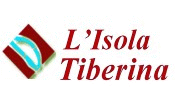The St Bartolomew Basilica
Article Index
THE WELL-CURB
 The position of the well-curb, currently inserted in the stairs leading to the main altar (pict.1), might correspond to that one of the ancient thaumaturgic source of the Aesculapius temple, representing the ideal link with it. The most credible hypothesis dates back its origin to the foundation of the Otto church.
The position of the well-curb, currently inserted in the stairs leading to the main altar (pict.1), might correspond to that one of the ancient thaumaturgic source of the Aesculapius temple, representing the ideal link with it. The most credible hypothesis dates back its origin to the foundation of the Otto church.
Obtained from the drum of an ancient column (the base is still recognizable), it is carved with four figures, inserted in small aedicules (pict.2÷5); starting from the figure facing the church inlet and proceeding counter-clockwise we find: Christ with the opened book, a saint (probably St. Adalberto) in Episcopal dresses with the pastoral and the closed book, the emperor Otto III holding a marble disc with the image of the ancient church and St. Bartholomew with the open book and the knife of its martyrdom.
Starting from the Christ image, and proceeding a gain counter-clockwise, the following inscription can be read, even if inserted irregularly on the background of the four figures:
gain counter-clockwise, the following inscription can be read, even if inserted irregularly on the background of the four figures:
OS PU-TEI S[AN]C[T]I - CIR CU[N]DANT - ORBE ROTAN TI
[The saints in a ring surround the well-curb]
On the upper part of the well-curb there are visible (pict.6) the trails of the ropes used to draw the water from the well and that made the inscription illegible.
THE CANNON BALL
In 1849, during the siege of the French army to the Roman Republic (just proclaimed on February 9th), that brought to the surrender of the republicans on July 4th of the same year, a gun ball shot from the Via Aurelia entered the church through the wall, miraculously falling without causing damages on the altar of the Virgo chapel (the one at the right of the main altar).
The ball has been walled up in the left side of the same chapel over a plaque commemorating the event: this is the text with the relevant translation at side.
|
BELLICUM HOC TORMENTVM |
This war bullet, |
THE MILLERS CHAPEL
In the room at the left of the main altar, formerly used as sacristy and subsequently rearranged as a chapel by the pope Giulio III in the half of XVI century, the roman millers settled the religious see of their corporation "Romana Molendinariorum ", under protection of St.Paolino, until 1846, and decorated it with scenes of their activity (pict. 7÷10). The restoration of the reliquary containing the relics of the saints kept in the chapel is referred to in the inscription shown on the trabeation at the inlet of the Basilica. On the floor there are traces of an ancient cosmatesco pavement.
The plaque walled up in the left side (pict. 11) quotes, over the image of a water mill, the following inscription, relevant to a restoration carried out in 1626:
|
CAPPELLA DELL'ARTE DE MOLINARI |
|||













